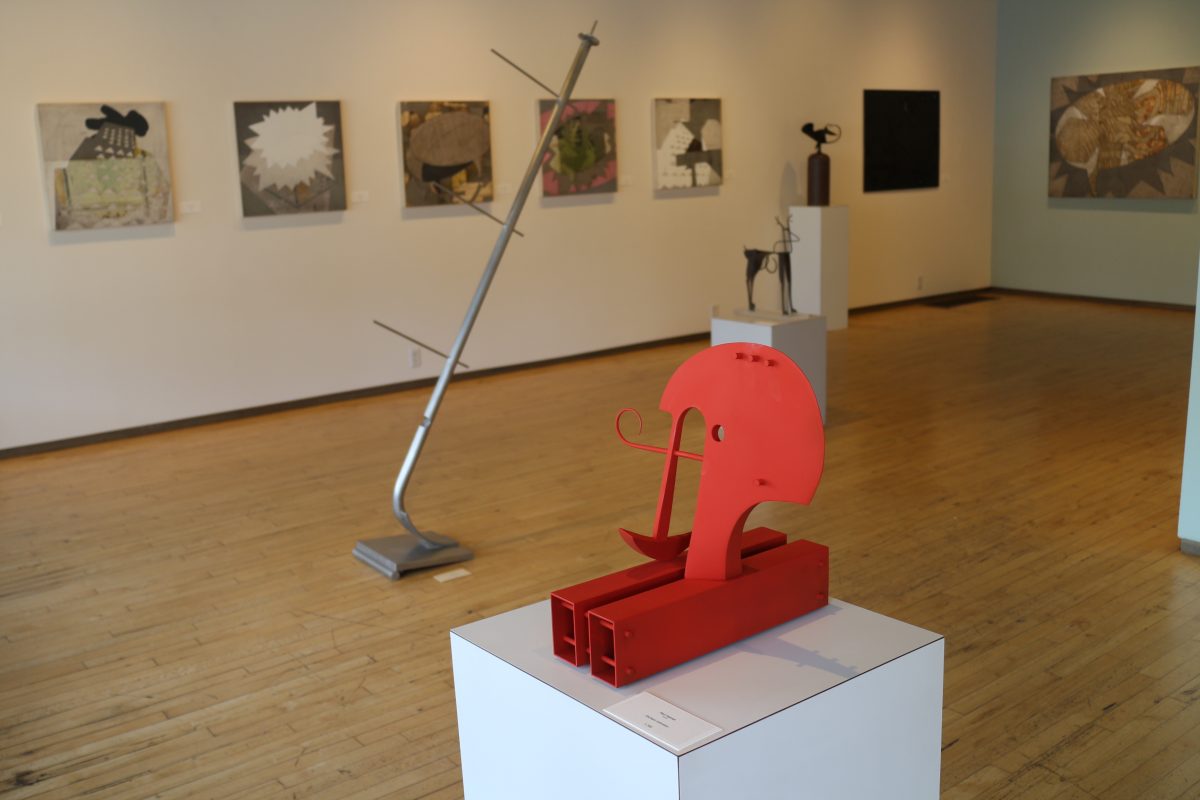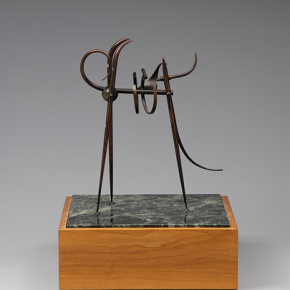Sculptures by Richard Johnston, including “Helmet” (front) with paintings by Joe Ostraff at Phillips Gallery.
Mahonri Young won his largest sculptural commissions in Utah only after he left the state (he had been in New York for three decades when he began work on This is the Place monument). Something similar happened to Richard Johnston. The former University of Utah professor garnered a number of important public art commissions in Utah only after he decamped for California State University, San Bernardino (it’s worth noting that no one took a blowtorch to Young’s commissions the way they did to Johnston’s). The current show at Phillips Gallery welcomes Johnston back to the state, with an exhibition of modest-size sculptures, as well as two-dimensional work, reminding us of what we’ve been missing for the past two decades.
Unlike Young, Johnston was not a native boy — he was born and raised in California — but, beginning in 1969, he spent two decades at the University of Utah, influencing a whole generation of students. He furthered his adopted-son bona fides with a stint as the director of the Salt Lake Art Center (now the Utah Museum of Contemporary Art). Then, in 1989, thanks to Utah’s 1 percent for art program, Johnston was commissioned to design his first public art piece in the state — President’s Grove at Dixie State University. The next year, however, he left Utah for California. In the decade that followed, Johnson received another eight commissions from the Utah Public Art Program, and installed large-scale works at the Ogden courthouses, Utah State Hospital, Weber State University, Dixie State Library, Salt Lake Community College and Utah Valley University.
It was in Orem that Johnston’s work ran into a blowtorch not his own. “Untitled Horse Form” had been installed at the University for five years when Gil Cooke, vice president for college relations of what was then Utah Valley State College, instructed a grounds crew to dismantle the sculpture and put it in storage. In the ensuing kerfuffle, Cooke claimed his actions were merely the first step in refurbishing and reinstalling the piece (it had begun to rust), but many within the arts community suspected a bloated case of philistinism was to blame. The Utah Arts Council, the sculpture’s actual owner, took custody of the dismantled remains until, in 2001, Johnston reinstalled the work at another location on campus. What had previously been a whimsical piece in buff gray with highlights of green and red was painted a somber black at its reinstallation.
While you’ll find yourself having to look up at Johnston’s public art pieces around the state, most of his work at Phillips would fit comfortably on a tabletop. Scale certainly changes one’s relationship to the pieces, but big or small they share a similar visual language. In “Pelican,” which is on the grounds of the Utah State Hospital in Provo, the titular fowl is evoked by a wide, flat, curling piece of metal, suggesting both the bird’s body and its throat pouch, contrasted against a thin rod that curves outward to where a short dowel forms a “T” — making it look like a pump handle with which to inflate the pouch, though one might also see a fish on the end of a beak. A similar juxtaposition of flat and thin can be seen at Phillips, where the curved shape of “Helmet” might suggest sporting gear if it weren’t for the rod of metal that juts out and curls, like a slithering tongue.
Animal motifs appear throughout the exhibition. Johnston is able to evoke a massive creature like “Elephant” with the spindliest of lines (there would be precious little here for the proverbial group of blind men to touch and describe). There’s the trunk, of course, drooping to the ground, and a curled tail that swats at flies, both mere filaments of line, and even the animal’s big floppy ears can be suggested with just one metallic stroke. The mass of the beast is a complete void, one framed however, by three thin posts, like the legs of a compass, which manage to suggest form out of thin air.
- “Elephant” by Richard Johnston,
- “Deer” by Richard Johnston, 2011, Steel and Acrylic, 20″ x 15″ x 5″
- “Elk” by Richard Johnston, Bronze, 20″ x 19 1/2″ x 12″
Tourist towns in the American West are littered with wildlife art made of metal, much of it generically “whimsical.” While Johnston’s pieces are playful, they manage, through a balanced elegance, to avoid the clichés that ruin the genre. At first glance, the legs and hoofs of “Deer” might appear too literal, while those of “Elk,” cartoonish, but there is a measured awe in these forms. A simple loop in “Elk” suggests the massive barrel chest of the animal, made more impressive by the thin legs; and the calligraphic line that forms the neck and head of “Deer” imbues the animal with a spiritual grace. These sculptures manage to be both weighty and light — Johnston understands, as Giacometti did, that you can say as much with absence as with substance.
His family sculptures employ a similar vocabulary, describing with thin lines, like contour sketches in the air, individual units within a circumscribed whole. Both “Circular Family” and “Family” feature a larger, central figure, with two smaller figures, as if to suggest a single-parent household. And not simply a generic one — in both, the right leg of the parent figure is askew, and characterized by a flap at what might be considered the knee or hip (depending on where one sees the body in these stick figures), suggesting a particular individual in both. In “Circular Family,” the figures are painted a bright, even red, while in “Family,” where the forms are lined up in a row as if posing for a picture, arms waving, the patina on the bronze conveys a sense of weathered history.
Johnston has said inspiration can come to him as much from the swirl of the ocean around a rocky shore as from a discarded piece of metal at Lockheed Martin, and the natural and the mechanical come in equal parts in his works. The latter is most obvious in a piece like “Wall Wing,” which is all flat masses with little negative space, the machine-cut pieces of aluminum looking freshly painted from the factory. Two freestanding sculptures, the largest in the exhibition, equally evoke the machine age. In his public-art sculptures, Johnston frequently employs a rod or tube as a base upon which to arrange a variety of fins or wings; in these two pieces, the rod seems to become more prominent, while the appendages have been reduced to mere wisps.
The exhibit also features two-dimensional works, sheets of aluminum or steel that have been lacquered or left to rust to create compositions. One can imagine the artist catching these spare sheets of metal in the studio with a sideways glance, then picking them up and turning them until they formed a pleasing composition. Unfortunately, the works do little to complement the sculptures (though “Moonscape” seems to suggest an unpolished section of one of Johnston’s sculptural pieces, pierced by an eerie light). Joe Ostraff’s paintings, which occupy most of the wall space, are a much better pairing with the sculptures, his layered, hard-edge compositions mimicking some of the visual components that make up Johnston’s art.
“Family” by Richard Johnston, Bronze with acrylic, granite and wood base, 30 1/2″ x 25 1/2″ x 13 1/2″
Does an artist, like a prophet, have to leave in order to be honored in his hometown (even if it’s an adopted one)? It may only have been coincidence that Johnston’s public art commissions came after he left the state (the percent for art program was only instituted in 1985, after all), but had they come sooner, might Johnston have stayed? If so, we would have had the pleasure of seeing many more of the elegant and evocative forms now on display at Phillips Gallery.
Paintings by Joe Ostraff and sculpture by Richard Johnston, Phillips Gallery, through May 12.
The founder of Artists of Utah and editor of its online magazine, 15 Bytes, Shawn Rossiter has undergraduate degrees in English, French and Italian Literature and studied Comparative Literature in graduate school before pursuing a career in art.
Categories: Exhibition Reviews | Visual Arts














